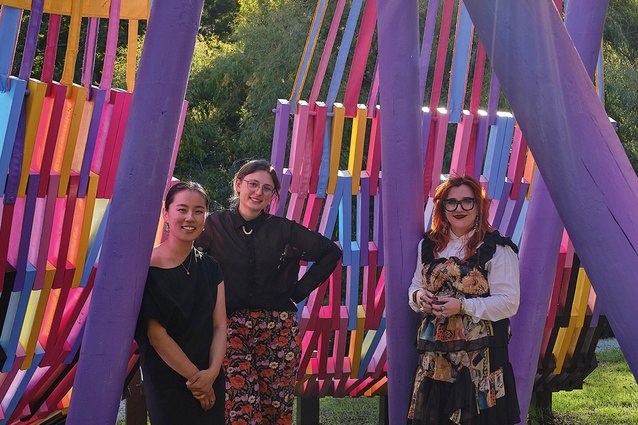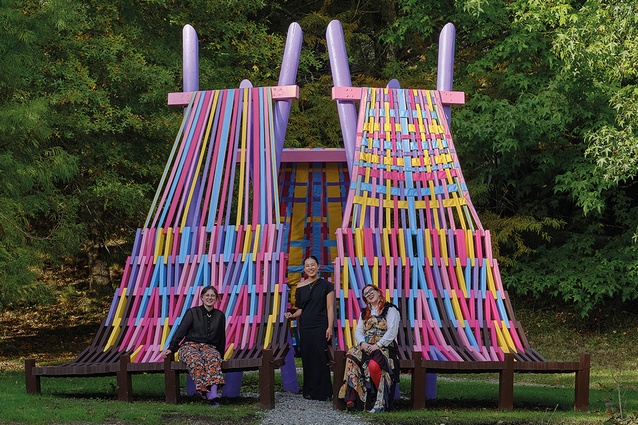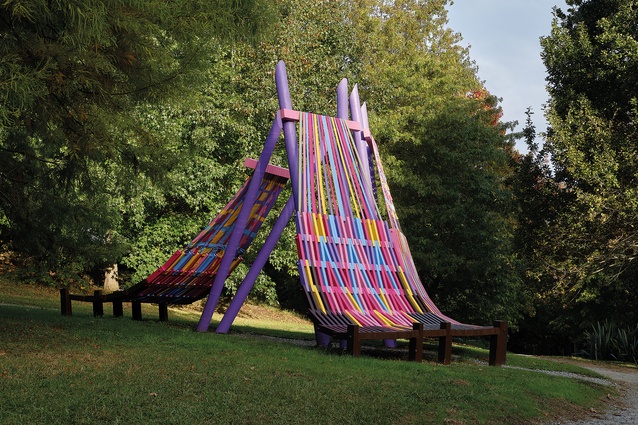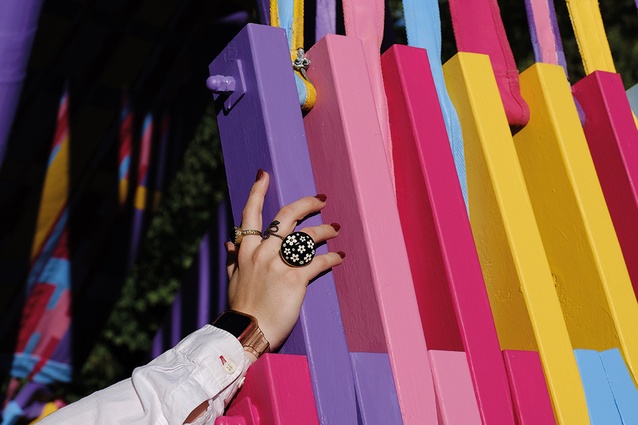2024 Brick Bay Folly winner announced
There’s a hint in the name — Femme-ly Velues — which references the fact that this is the first all-women project team to have built a folly amongst the nine flights of fancy constructed to date.
On a deeper dive, it transpires that ‘femme’ alludes to the role of the matriarch in knowledge-sharing, and that ‘velues’ was originally a loose play on ‘family values’ but with a Kiwi twang.
This year’s team, made up of Claire Ford, Elise Cautley and Jennifer Gao of Yellowhammer Services, Architecture HDT and Jack McKinney Architects, respectively, joined forces to design a concept based on the fabric crafts they’d been taught by their mothers. “We were interested in drawing on the idea of sewing and weaving, and how that translated into a hard-material architectural form,” explains Cautley.
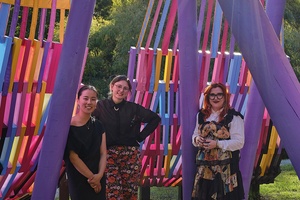
After a number of initial sketches, they landed on the draping form, where three distinct elevations depict the different elements of weaving. “The three stages are much like the relationship of learning and teaching,” says Ford, “where you learn the basics and then add more and more complexity.” Each of the three looms represents a separate stage of creating a woven piece: warp (verticals), weft (with horizontal shuttle) or work (tensioned and compacted).
“In stitching, weaving and knitting, you add, piece by piece, and the intricacy of many parts makes the whole,” says Gao. “And this was reflected in the construction methodology, on site as well as in our building process; the canvas was individually stitched then woven, then the timber batons were threaded together, one by one.”
While the original design concept remained true to the early drawings, the learnings came in the construction details, taking an elegant sculptural render and ensuring its structural integrity without compromising its aesthetic. “What are we going to do if seven seven-year-olds decide to jump around in the middle of it?” says Cautley. “We needed to communicate strength in something that looked light and playful. We wanted the folly to be completely interactive for everyone, be it a seat or a small imaginative world, so structural integrity was particularly important.”
With guidance from mentor Pip Cheshire, the design was adapted to hide strengthening steel cables cleverly within the sleeve of the canvas on the loom. “In weaving, when you make ripstop nylon or similar tech fabrics, every 10th thread or so is actually a stronger material,” Ford points out. “So, our method tied back to the source material, too.”
The strengthening structure is expressed as a colourful binding stitched to the edge of the vertical warp elements.
Gao says no matter how much the team had planned and prepared, once on site, as with all architectural projects, there were things no one could have predicted. One of the biggest challenges was the compacted gravel foundations they chose over the more commonly used concrete. “This approach was new both for Brick Bay and for us,” says Ford. “It fitted so well with our values and it meant we were leaving material on site that can be used again and again but we had no idea quite how much time and effort it would take.

Three 1.2-metre-deep holes, into which each of the six posts was cantilevered, led to the team having to compact 11 cubic metres of gravel into the foundations, disrupting the build schedule by about a week.
The project embraces sustainability and the use of local resources, with much of the timber being from the previous folly on that site, The Nest, representing the third re-use of this material.
The canvas and structural tension wires were made by Auckland-based studio Goatloft. “Textile manufacturing and architecture are different worlds, using different languages,” says Ford. “They knew which canvas would take the Resene paint most successfully — an equine canvas, typically used for horse coats — and it’s given us a really artistic finish.”
Cautley says the colour scheme spoke to the joyful mood and playful atmosphere they were looking to create. “The pinks are very topical in terms of the current Barbie-fication of femininity, the purple references International Women’s Day, and the blue and yellow are found on flags of diversity. The bright, inclusive colours also complement the green of the site.” The brown at the base of the looms is the original stain of the timber from The Nest.
The team says they couldn’t have completed the project without a huge amount of help with the build from Cassidy Construction and vital engineering advice from Structure Design’s Peter Boardman. Unitec’s Keith Mann facilitated the offsite assembly of the timber portion of the looms, as well as a space at Victoria University of Wellington. Both Cautley and Ford are based in the capital.

The learnings on the project were many. Gao says being on the tools was a big plus for her as an architect, while Ford, herself a builder, enjoyed working on a self-directed artistic project. “It was very whimsical but, next time, I’d go for slightly fewer angles,” she says. “I spent so much time with a trig calculator trying to figure out how much rise and run would give us the angles that we needed against the site, which is also sloping, and posts that are angling in three directions at once. It was a lot of maths.” Cautley, a planner at heart, says the experience taught her to be adaptable and resilient; “Nothing beats being thrown into a deep hole and having to tamp your way out. It’s given me much more confidence to take back to the office.”
“The project was an exciting proposition for us all when we first saw it,” says folly judge and mentor Pip Cheshire. “The combination of rigid and flexible materials, the importance of the loomed fabrics’ curve, the flamboyant colouring and a design team split between cities all gave pause for reflection.
“As usual, a beguiling competition submission had challenges concealed within, many well beyond the experience of those of us more steeped in building construction. I am delighted the team of competitors, with judge and mentor support, overcame these and Brick Bay is yet again host of a folly that meets with bravado the challenges laid down by the competition.”

This year’s judges were Pip Cheshire from Cheshire Architects, Steve Cassidy from Cassidy Construction, Karmen Hoare from Resene, Peter Boardman from Structure Design, Keith Mann from Unitec, Chris Barton from Architecture NZ, Richard and Anna Didsbury from Brick Bay, and William Creighton from the 2023 Folly winning team, whose folly was named Te Reo o te Hau, The Voice of the Kōkōhau. Brick Bay Folly is sponsored by Resene, Cassidy Construction, Cheshire Architects, Structure Design, Unitec, Architecture NZ, ArchitectureNow, Sam Hartnett Photography and Brick Bay.



